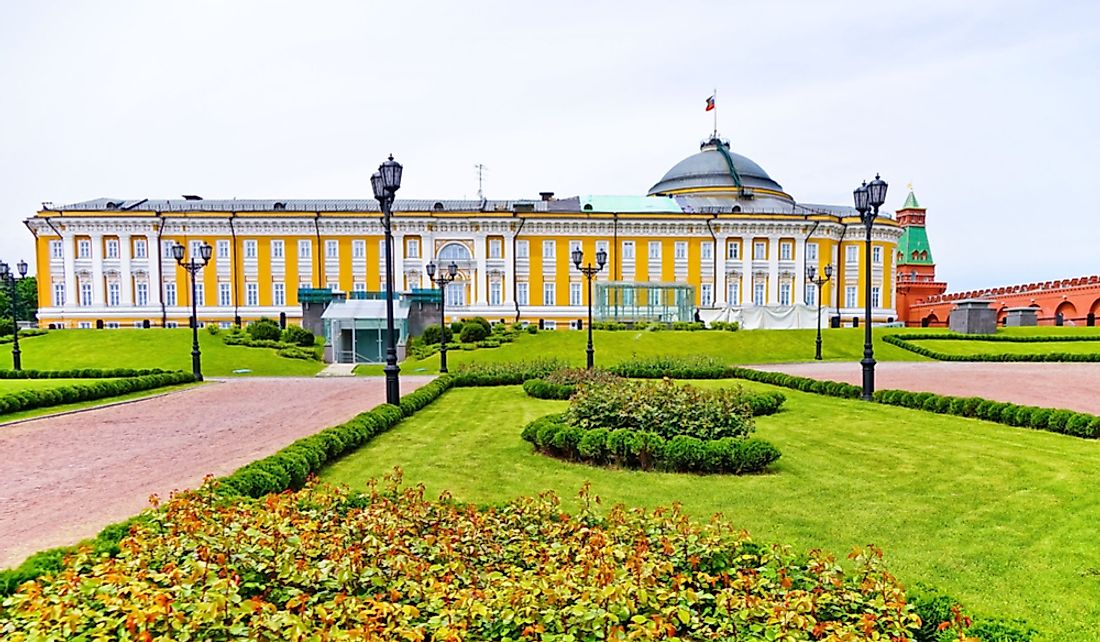Where Does the President of Russia Live?

Russia is governed as a federal republic with a President as the head of the state and a Prime Minister as the head of the government. The Kremlin Senate is the official residence of the President of the Russian Federation. The Kremlin has remained at the heart of the capital city of Moscow throughout its history.
History of the Krelim
The Kremlin has served as a symbol of Soviet and Russian power and authority. The 20 towers of the Kremlin as well as the crenelated red brick walls were built by Italian builders at the invitation of Ivan III towards the end of the 15th century. The Kremlin is a striking architectural piece, and it consists of palaces and cathedrals and the highest government offices protected by strict security.
The Kremlin Towers
The Spasskaya Tower was built by Pietro Solario in 1491. It is one of the most important towers leading to Red Square. The belfry was installed on the tower between 1624 and 1625. Solario also helped design most of the other towers. The tower clock's chime is usually broadcast to the whole country by radio as a time signal.
Other key towers on the Red Square include the Nikolskaya (St. Nicholas) Tower which was built in 1491 and later rebuilt in 1806, the Troitskaya (Trinity) Tower, the Kutafya Tower (Outer barbican), and the Borovistskaya Tower.
The Kremlin Cathedrals
The Cathedral Square, which is centrally located, is surrounded by three magnificent cathedrals that represent the church's architecture in the 15th and 16th century.
The Cathedral of the Assumption was built between 1475 and 1479 making it the oldest. The Cathedral of the Assumption was built with white stones with an Italianate-Byzantine style and consists of elegant arches crowned by five golden domes.
The Cathedral of the Annunciation was built by Pskov between 1484 and 1489, and it was however burned down in 1547 and was rebuilt between 1562 and 1564. The cathedral chapels are crowned by golden domes and roofs while the icons inside are attributed to great painters such as Andrey Rublyov and Theophanes the Greek.
The Cathedral of the Archangel was rebuilt between 1505 and 1508 and it was dedicated to the Archangel, St Michael. The tsars of Russia and the Princes of Moscow were buried here until Saint Petersburg was founded. Other attractions include the beautiful Ivan III white bell tower that was constructed in the 16th century, the gigantic Tsar Bell which was cast between 1733 and 1735, and the enormous Tsar Cannon which was cast in 1586.
The Cathedral of the Twelve Apostles and Patriarchal Palace are also found close-by. A group of palaces that were built across the various periods are located on the west of Cathedral Square.
The Kremlin Palaces
The Palace of Facets which gets its name from the faceted white stone exterior was built between 1487 and 1491. The Terem Palace is found behind the Palace of Facets. It is comprised of several older churches and was built between 1635 and 1636. Both palaces were made into royal residences between 1838 and 1849 and were used for sessions of the Supreme Soviet of the Soviet Union.
The Armory Palace was built between 1844 and 1851 and currently houses the Armory Museum which has Tsar treasure collections. The Arsenal, which was built between 1702 and 1736, is found along the northeast wall.
Other buildings in the Kremlin include the School of Red Commanders, the former Senate building and the Palace of Congresses which is used for political gatherings.
The Change In Roles
The Kremlin, which means "fortress inside a city" has had its primary role changed from a fortress in medieval Russia to a center of governance and seat of power, a role it currently holds. Various sections of the Kremlin palace represent various periods in the nation's history. It currently attracts about 2,746,405 tourists annually.











